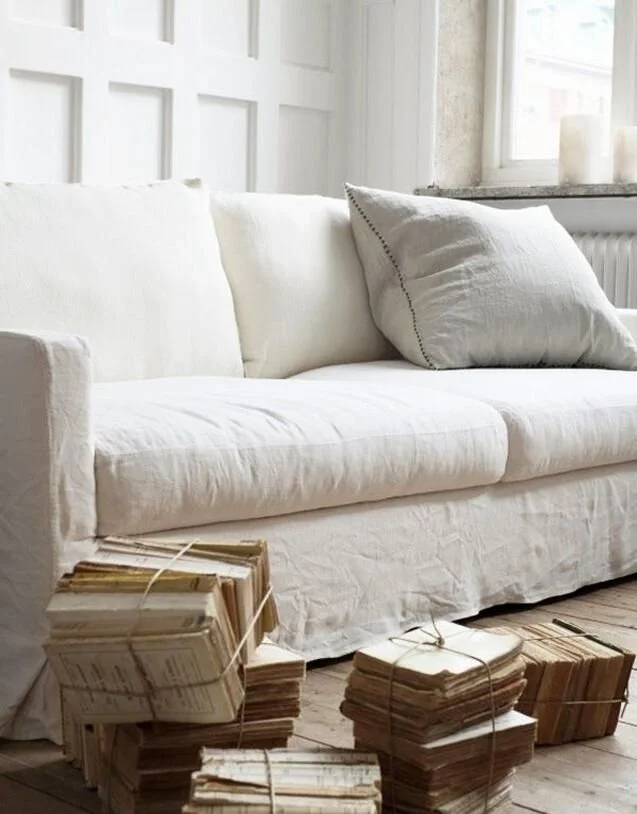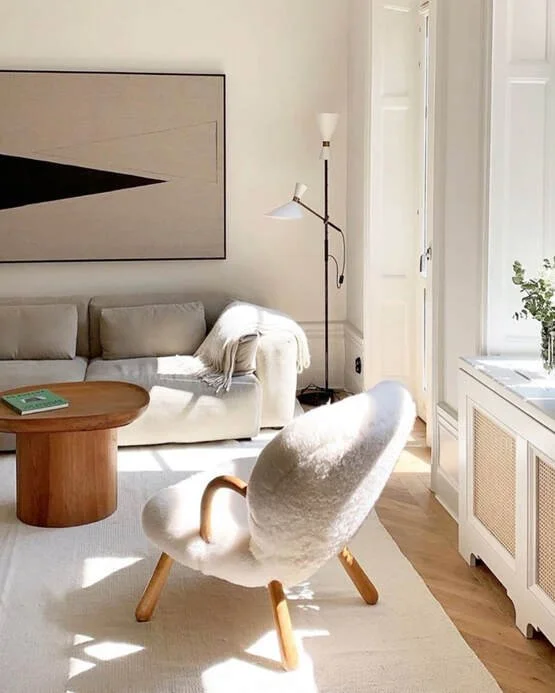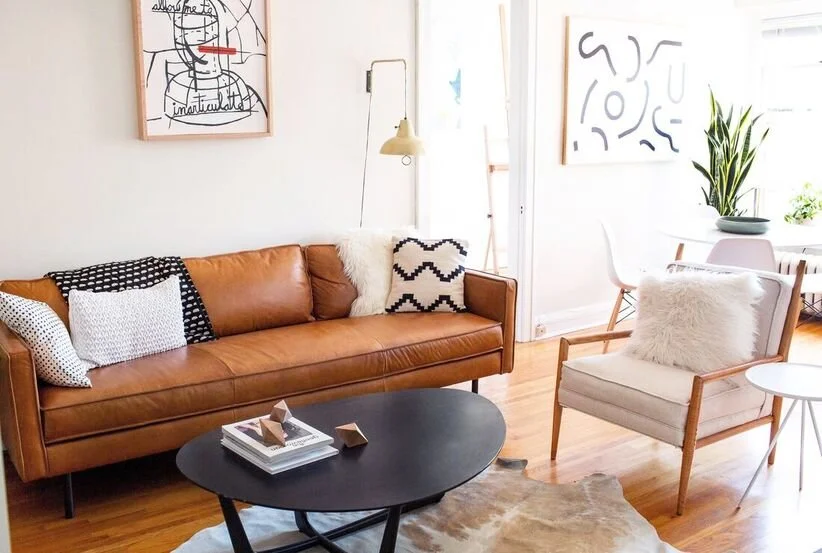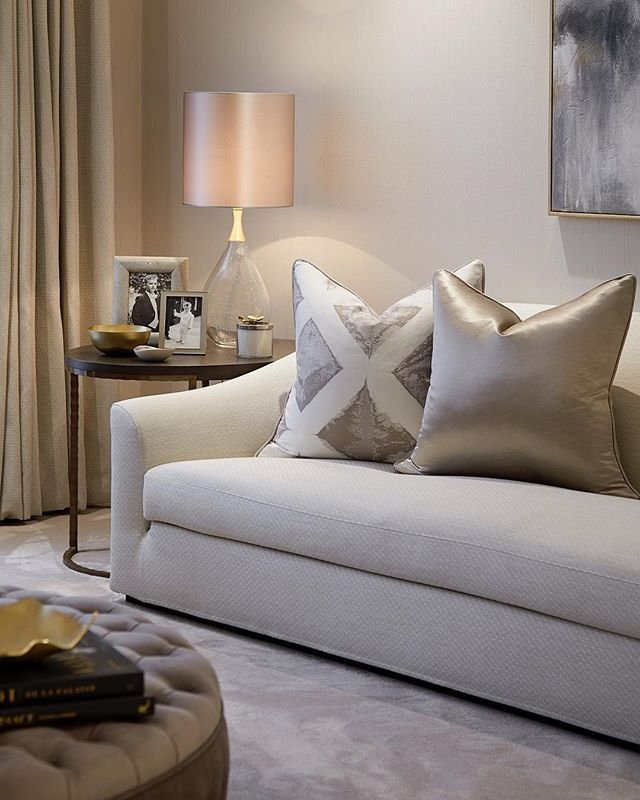Natural Fabrics: Pros & Cons
Corner sofa in wool fabric (image via Pinterest)
On the side of my studies at KLC School of Design, I am working part-time in a soft furnishing showroom in central Stockholm. My customers often ask me which fabric is more suitable for their sofa, curtains, bed valance or headboard. The choice of fabrics for homeware is so vast and each fabric has its own characteristics, which make it unique and more suitable for a type of furniture than another one. This is why I decided to write a guide with pros & cons of the most common textiles.
Textiles in general can be divided between natural fabrics and man-made. Under the most common natural fabrics umbrella, we have:
Linen
Cotton
Wool
Leather
Silk
Let's check some inspiring images and pros & cons of each natural fabric. Another blog post will follow with man-made fabrics, such as: velvet, acrylic, microfibre, vinyl, etc.
1. Linen
Linen fabric is very breathable, ideal with hot temperature (image via Pinterest)
Without any doubts linen fabrics are among the most sought after by all Scandinavian style lovers. With its lightweight, it serves well a loose fit style for your sofa, blending perfectly in the Scandinavian style philosophy of simplicity and practicality. It comes in a variety of colours, and one of my favourite supplier is surely Designers Guild with their Brera Lino collection, very soft fabrics 100% made in linen.
Linen fabrics are suitable for a more causal and relaxed look (image via Pinterest)
Pros of Linen:
eco-friendly: this fabric is made from the flax plant and it doesn't require the use of pesticides.
very breathable making you feel very fresh after sitting on it (this is why I recommend it in summer houses or very hot countries).
hypo-allergenic: resistent to mildew and microflora, linen is great for those who are sensitive to allergens.
easily cleaned: most covers can be stripped off your sofa and put in the washing machine.
soft, natural and it can give your home a more casual look.
Cons of Linen:
it wrinkles and creases: this is why it is better to choose a blend with cotton or a synthetic fabric that will make it more durable.
not so durable: these fabrics usually have a Martindale result of 20,000-28,000 which makes them not so resistant for long period of time. If you do not know what is a Martindale test, you can read it in my blog here. It is recommended on curtains and bed valances.
it is not stain resistant and therefore it absorbs spills of water and wine. You will have to wash it every time a little accident happens. You can also ask your supplier if the fabric can be, or it is already, treated to be stain resistant.
2. Cotton
Cotton fabrics are very durable and easily washable (image via Pinterest)
Cotton is a very common fabric for sofa and armchairs and it is, most of the time, blended with synthetic fabrics to maintain a low price. If it is blended with linen, it can still allow a more casual look and it will result a much softer fabric than a 100% cotton. A very beautiful collection of washable soft cotton fabrics is Osumi by Romo.
Pros of Cotton:
durable and washable: it is very resistant to usage and therefore adapt to high traffic furniture as your sofa, furthermore it is easy to remove sofa covers in cotton and wash them in the washing machine.
breathable: like with linen the fact that this is a natural fabric, it makes it very breathable.
resistant to pilling.
price friendly: because it is so easy to produce, cotton is among the cheapest fabrics on the market.
Cons of Cotton:
it absorbs dyes: the fact cotton absorbs so well dyes, it means also that it absorbs any dyes, even unwanted. For example, if you sit with your jeans and they tend to loose colour, on a light coloured cotton fabric, you will notice right away the stain.
it wrinkles as well with usage but not as much as linen. It is therefor better to pick a cotton fabric blended with synthetics.
3. Wool
Mid-century modern Living Room
Design: Fredrik Karlsson Interiors
In 2019 we saw a trend in interiors with a revival of the Mid-century style including wool in upholstery. I am sure that it is not going to disappear that quickly in 2020 and we might still see lots of vintage furniture and 70s design icons into our homes. This boucle wool waves have surely a very nice tactile effect, to give your sofa an exclusive sensorial experience. Wool is a great fabric for a mountain cottage or Nordic home, but it can be used on contemporary homes too. It can be a great contrast for example to hard materials, like in the picture above with a marble table. Contrasts are in my opinion an original and creative way to pull together a scheme. A supplier with a wide range of wool fabrics is the Danish Kvadrat. I have been working with them for a while and their quality is always very good.
Pros of Wool:
Soft and insulating: wool will definitely keep you warm and have a very nice tactile effect.
Resistant to mould: since it repels moisture, wool is also resistant to allergens and mould.
Fire retardant: if you are working on a commercial project, this fabric can be a nice option.
Cons of Wool:
Too warm for hot temperature.
More expensive than cotton and linen, it can come with a price tag to think about.
4. Leather
Leather is durable and timeless (image via Pinterest)
Leather is a versatile and beautiful fabric that always give a luxurious and masculine touch to any furniture, mostly in dark colours. When I was young, in Italy, a white or black leather sofa was absolutely a status symbol. Despite the ethic side, leather is a very durable material and a great option for upholstered furniture. One of my favourite supplier is surely Whistler from London and Altfield's faux leather collection
Leather is low maintenance and it gets better with aging
Pros of Leather:
while all other fabrics get worse with time, leather gets better with time. It acquires an attractive patina with time and becomes softer.
highly durable: while many think that leather is delicate, this is a very durable and spill resistant fabric.
very low maintenance: a simple swipe sometimes and some conditioner to make it shine and this fabric will always keep its luxurious look.
odours resistant: since leather isn't really absorbent, it resists bad smells.
Cons of Leather:
Not great at extreme temperatures: it won't provide warmth like wood or cotton in cold temperature and it won't be as breathable as linen during hot days.
It is an expensive fabric: its durability and luxurious look come with a price.
5. Silk
Silk is without any discussion the most luxurious fabric on the market. With its glossy effect it makes shine and rise any room and home. Since when it started to be imported from China to Europe, arriving first in Venice, silk has been a status symbol for the wealthier people. One of my favourite supplier is surely Rubelli, a family run business from Venice who started during the wealthy years of the Silk Way. Another astonishing collection is the one from Sahco and, a linen blend collection from Lelievre Paris is also absolutely remarkable.
Silk is recommended for light upholstery such as cushions.
Designer: Laura Hammet Interiors
Pros of Silk:
a timeless fabric for a very luxurious look. Silk will donate to your home a touch of royalty and exclusiveness.
silk doesn't do wrinkles so easily as linen or cotton.
Cons of Silk:
it is very expensive, although there are some valid faux silk alternative on the market that are worth to be considered.
not durable: the Martindale Test results are usually very low which make it more suitable for low traffic upholstery or decorative objects such as: cushions or curtains. It is more resistant for your sofa in the velvet variety.
silk is not waterproof: water stains will remain and even a small drop can become large and very unaesthetic.
sunlight damage: the colour of this fabric can fade when exposes to direct sunlight, and it also causes the fibers to wear down easier which it can lead the fabric to rip apart.
This is the conclusion of the first part of my homeware textiles guide about pros & cons of natural fabrics. In the next blog post I will talk about man-made fabrics and their possibilities for upholstery. Man-made fabrics are really an excellent choice for anyone looking for cheaper options to leather and silk with still the same incredible qualities and fabulous look. Technologies are so good nowadays, that we are able to obtain incredible identical fabrics but with much stronger and more durable fibers.
I hope you found this article useful and that it helped you solve some of the questions you may had about the right fabric for your sofa. If you are still unsure on what to purchase or simply feeling overwhelmed by the wide range of textiles on the market, do not be afraid to reach out. I will be more than happy to help you find the right fabrics for your home. I have been exposed during my previous jobs and studies to many suppliers and I gained a valuable knowledge about homeware textiles.
You can reach me on my Contact page or at my email: claudia@interiorsbyambrosi.com.
Thank you for reading!







